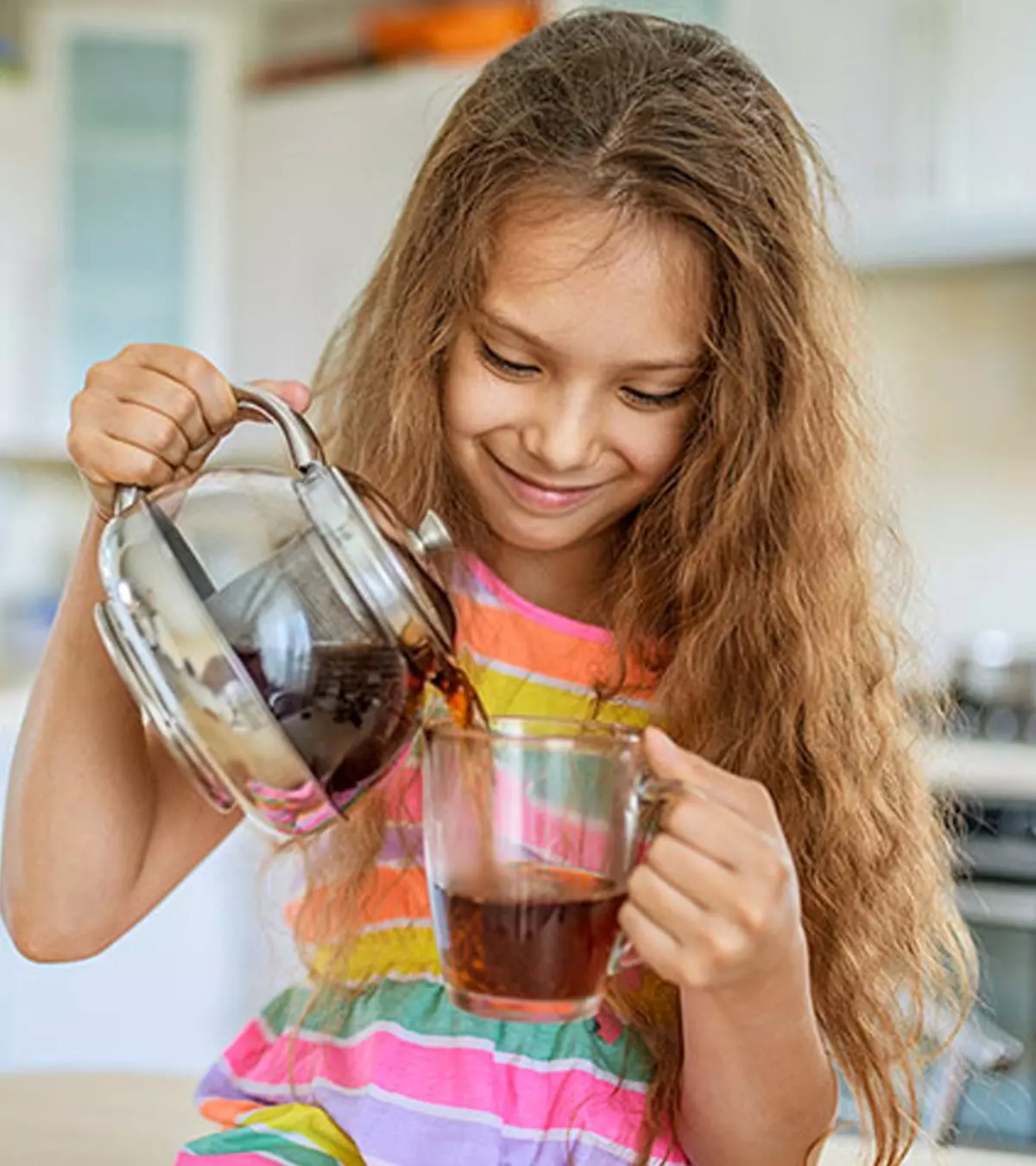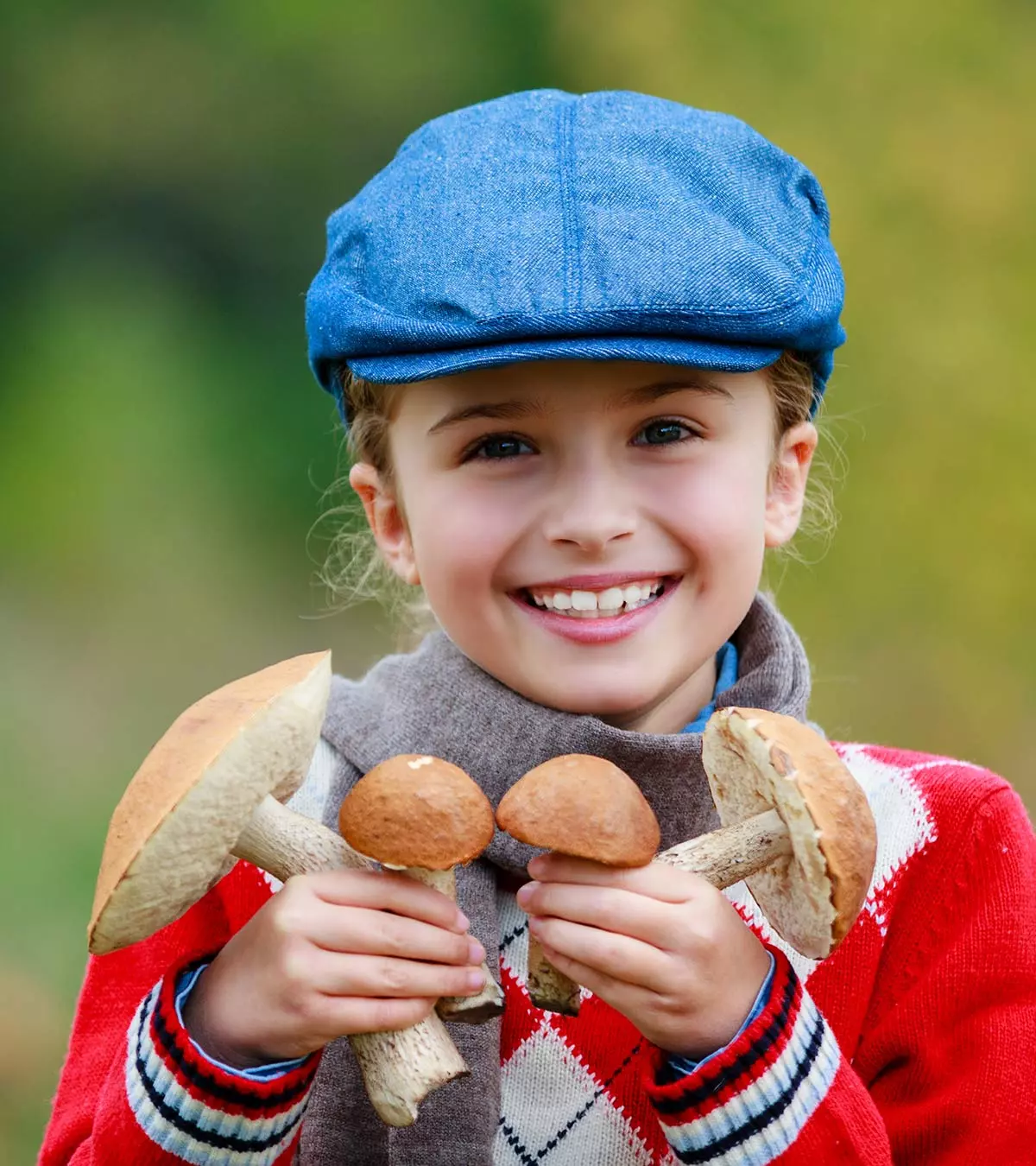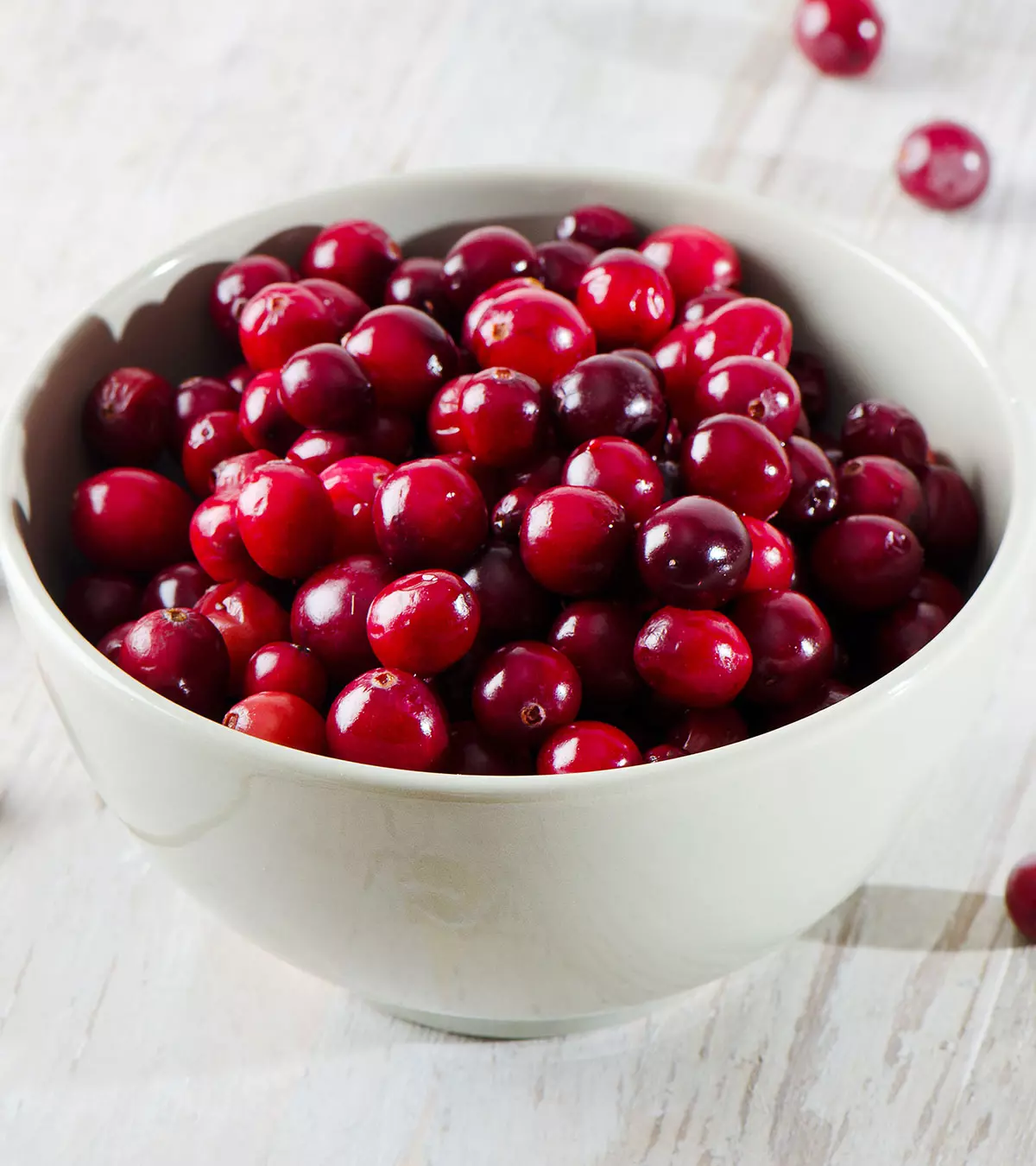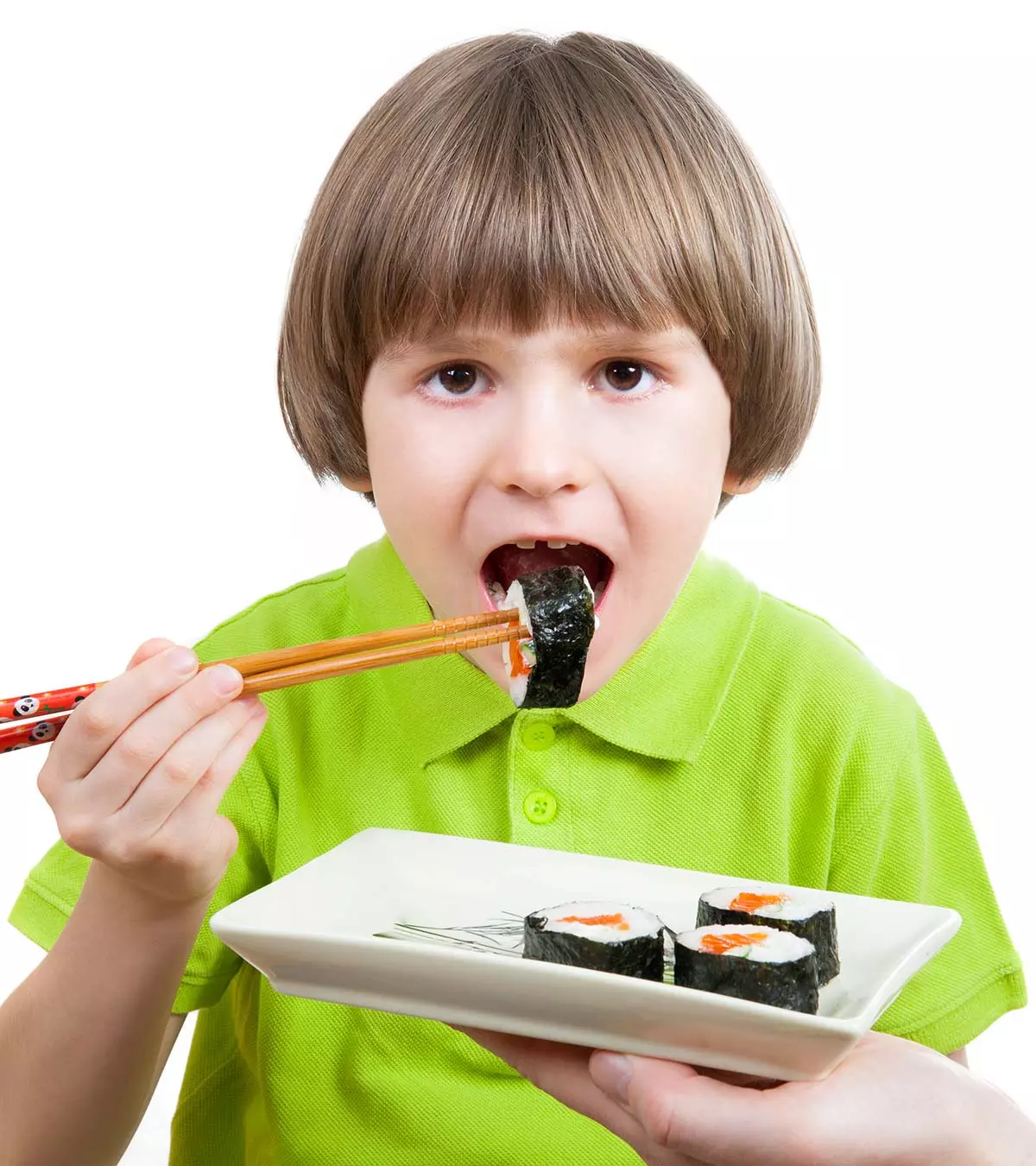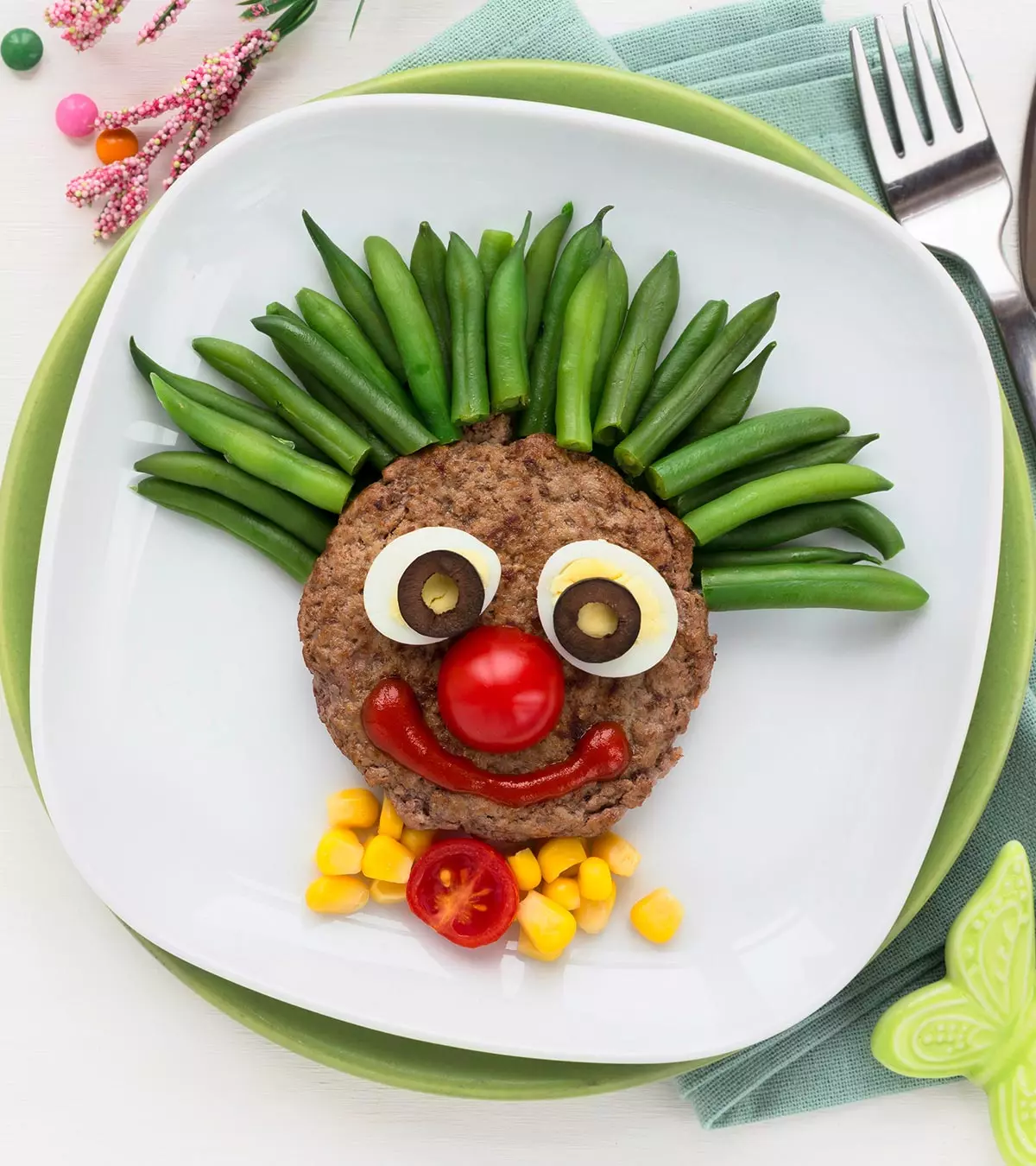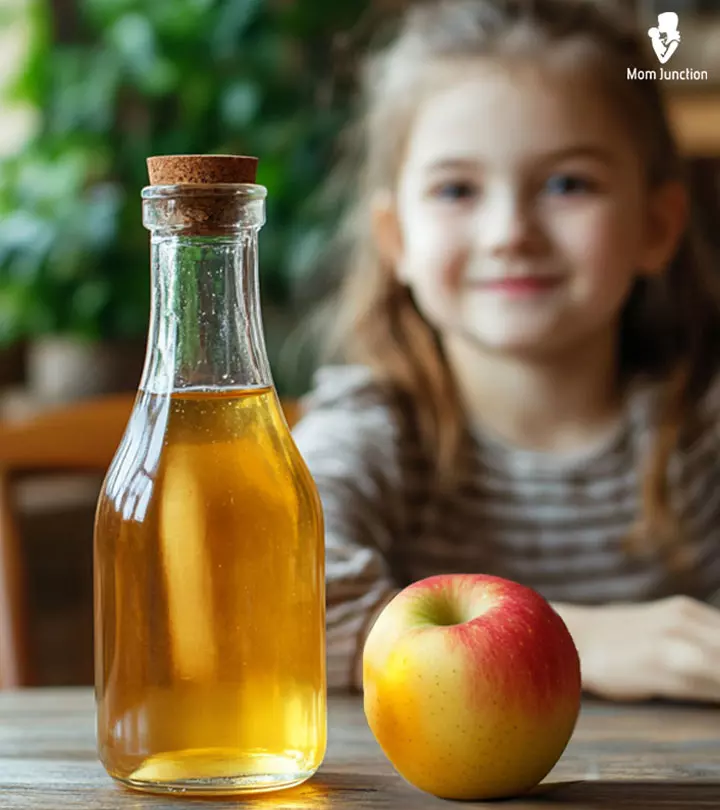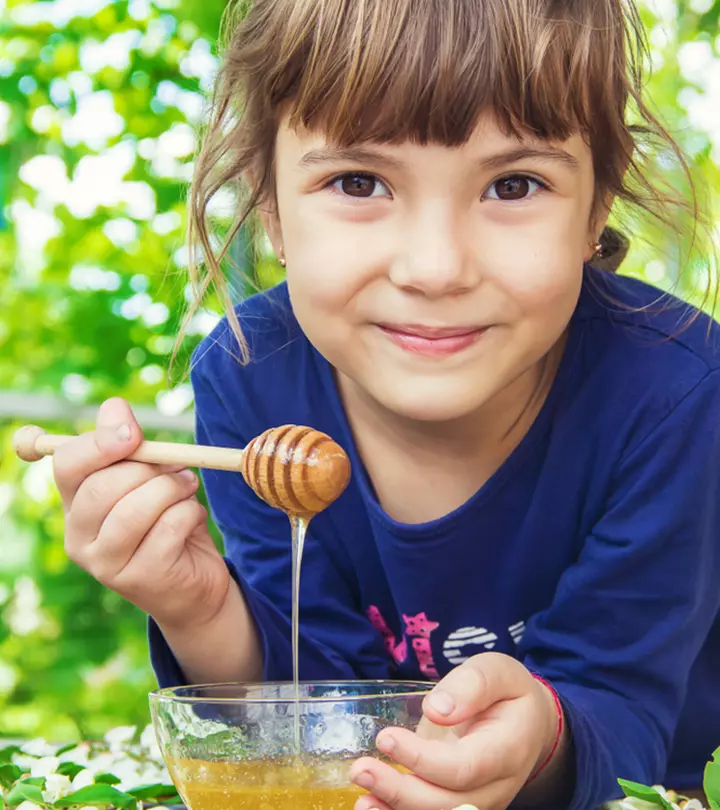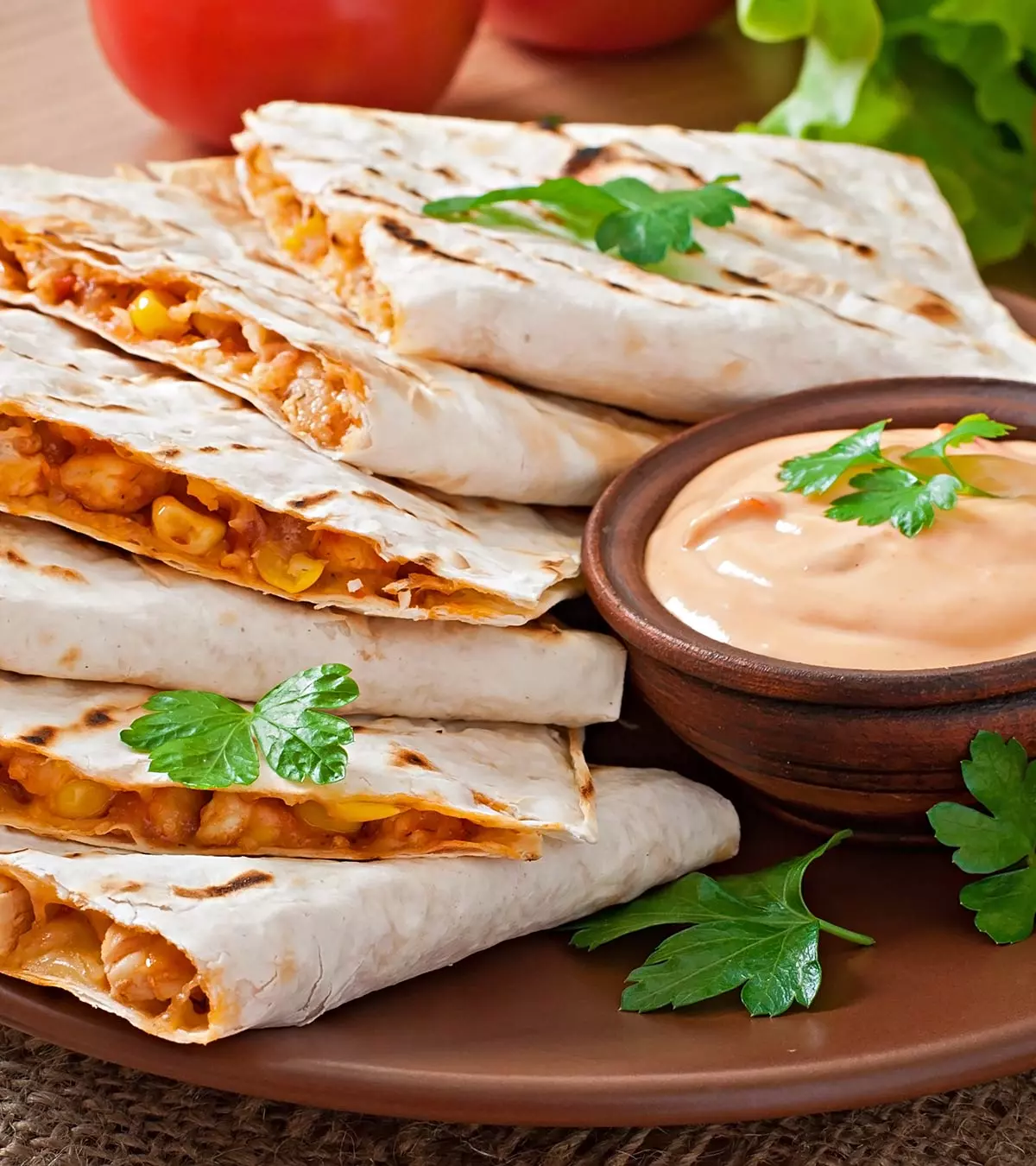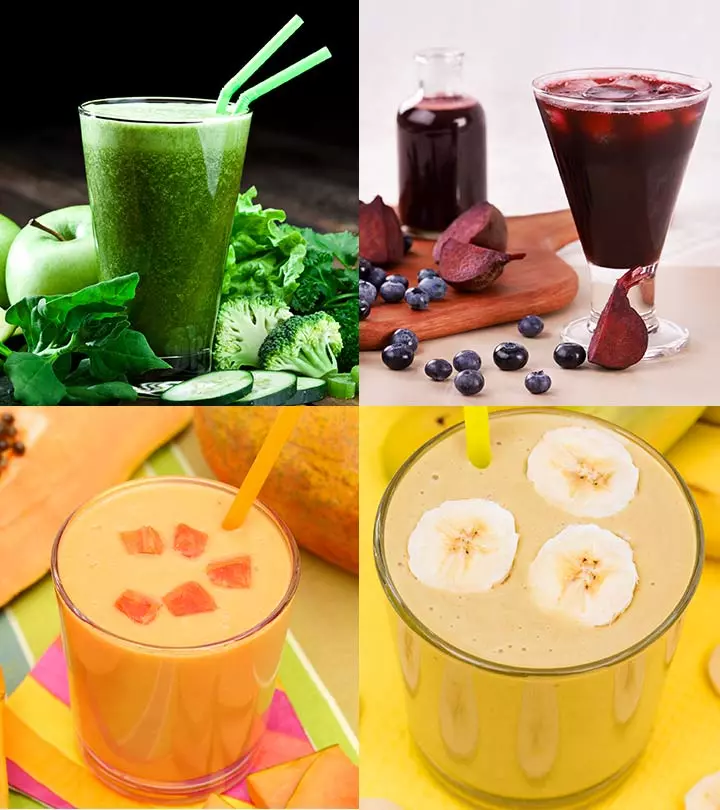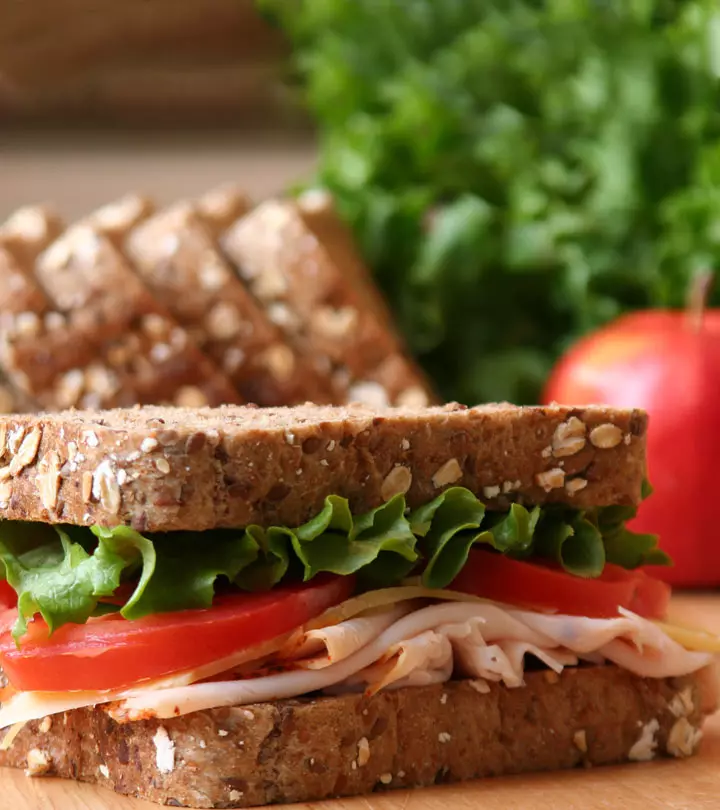
Image: iStock
Salmon is a fatty fish that is a good source of lean protein, omega-3 fatty acids (EPA and DHA), vitamins, and minerals (1). Therefore, if you are confused about the safety of salmon for babies in the weaning stage, know that it could have numerous benefits. However, before adding it to your infant’s diet, learn more about the nutritional profile and the age-appropriate ways to introduce it. Read this article to learn about the health benefits and potential risks of consuming salmon and some delicious ways to cook salmon for your baby.
Key Pointers
- Salmon can be served two to three times a week when you start weaning your baby.
- It is enriched with nutrients such as vitamin D and B, calcium, and omega-3 to promote healthy growth and build immunity.
- Before feeding salmon to your baby, it is essential to follow some cooking tips and necessary precautions to avoid any adverse reactions.
- Delicious recipes such as salmon frittata or sweet potato fish cakes may be a good way to start.
Is Salmon Safe For Babies?
Yes, salmon is safe for babies. “As it is low in mercury, it is safe for babies to eat salmon two to three times a week,” says California-based pediatrician and health advocate Dr. Pierrette Mimi Poinsett. Additionally, it can help in diversifying your baby’s palate from a young age.
Eating salmon can offer nutrients such as vitamin D and calcium, which are necessary for healthy bone development (2). Besides, it is rich in omega-3 fatty acids that aids in the central nervous system (brain and nerves) and eye development (3). It is why experts consider salmon a vital seafood option for babies and toddlers (4).
Note: Although fish is a common allergen, “there’s no need to delay its introduction in babies,” says the American Academy of Pediatrics (AAP) (5). However, if your baby has any other food allergies or has a family history of fish allergy, consult your doctor before feeding any fish, including salmon, to your baby.
When Can Babies Eat Salmon?
According to Dr. Florencia Segura, pediatrician and fellow of the American Academy of Pediatrics (FAAP), “Salmon is an excellent baby food because it is easy for babies to finger feed due to its soft and flaky nature.”
It means a baby’s diet can include fish within a few months of starting solids (6). A study conducted on 3,285 children from a prospective Swedish birth cohort found that by the age of one, 80% of the children consumed fish regularly (7). Thus, babies older than six months, who are eating various solid foods, can eat steamed, baked, or boiled salmon in puree and mash forms as they are easily digestible. Alternatively, you can serve salmon in small pieces as part of baby-weaning food. As the baby grows, they can consume different roasted, poached, pan-seared, and grilled salmon dishes across meals.
According to the Centers for Disease Control and Prevention (CDC), you should remove all the fat, skin, and bones from the fish before trying fish recipes for babies (8). Removing fatty skin ensures you reduce the baby’s exposure to toxins, such as PCBsiPolychlorinated biphenyl (PCB) is a chemical that can pollute the environment and lead to health issues (9). On the other hand, separating bones minimizes the choking risk. However, it is necessary to monitor children when they are eating. The New York State Department of Health states, “Never leave a small child unattended while eating. Direct supervision is necessary (10).
”Nigella Lawson, a mother, discusses how she prepares fish for her baby. She explains, “Fish is a very important part of the weaning diet. I have made these fishcakes with both salmon and cod. Break up the fish into flakes, taking care to ensure there are no bones (i).”
Nutritional Value Of Salmon
There are six types (Atlantic, Chinook, Chum, Coho, Pink, and Sockeye) of salmon available in the US in fresh, canned, and frozen forms (1). The nutritional composition of these types varies from one another.
Here’s the approximate nutritional composition of three ounces of raw pink salmon against the recommended dietary allowance of vital nutrients (11) (12).
Nutrients | Amount | RDA (7-12 months) |
Energy | 108Kcal | – |
Total lipid (fat) | 3.74g | – |
Protein | 17.4g | 11g |
Calcium, Ca | 5.95mg | 260mg (AI) |
Magnesium | 23mg | 75mg (AI) |
Potassium | 311mg | 860mg (AI) |
Sodium, Na | 63mg | 370mg (AI) |
Iron, Fe | 0.32mg | 11mg |
Selenium | 26.7µg | 20µg |
Vitamin A | 35µg RAE | 500µg RAE (AI) |
Vitamin D (D2+D3) | 370IU | 400IU |
Source: Food Data Central and Dietary Guidelines for Americans 2020-2025 AI = Adequate intake – nutrient level assumed to ensure nutritional adequacy IU = International Units
Note: You may hear or read information urging you to choose wild salmon over farmed ones as they are low in contaminants. However, the Washington State Department of Health notes that “both wild and farmed salmon have low levels of mercury, PCBs, and other contaminants (13).”
Health Benefits Of Salmon For Babies And Toddlers
Salmon is a nutrient-rich soft food that can contribute to your baby and toddler’s daily nutritional needs and impart the following benefits:
1. Supports growth and development: Fish offers nutrients, such as high-quality lean protein, vitamin D, and calcium. The body uses these nutrients for several functions, such as cartilage and skin development, tissue repair, and bone and muscle growth (14). Similarly, fish provides omega-3 fatty acids (EPA and DHA), which support the central nervous system, eye, and immune system development (15).
2. Facilitates physiological functions: Fish offers several B vitamins, such as B3, B6, B9, and B12 (14). Babies and toddlers need these vitamins to perform different physiological functions, such as energy metabolism, red cell production, and hormonal balance. Likewise, iodine in fish ensures proper thyroid function.
3. Helps combat inflammation: Nutrients, such as omega-3 fatty acids, vitamin E, and selenium found in fish, helps combat inflammation (16). Likewise, astaxanthin is an antioxidant in salmon that fights free radical damage, reduces inflammation, and boosts immunity (14). It is the same pigment that gives salmon its pink color.
Besides these, fish consumption is associated with several long-term health benefits, such as improved brain health and reduced risk of neurodegenerative diseases (17).
How To Select And Store Salmon?
Proper selection and appropriate storage of salmon are essential to ensure its quality and safe intake. Here are some tips that you should keep in mind.
Fresh salmon
- First, smell the salmon. A fresh salmon doesn’t smell like fish. Ideally, it will have no smell at all.
- Check the skin. It should be clean, shiny, and slippery to touch, and its gills should have deep red to pink color with marbling.
- Avoid salmon with any brown spots or bruises around the edges or its belly. If its edges are curling up, the fish is most likely not fresh.
- Take a careful look at their eyes. A fresh catch will have clear and bright eyes and not sunken or cloudy. Also, they will be firm to touch.
- If buying a fillet, poke its flesh. A fresh salmon flesh bounces back upon poking. Also, it doesn’t leave the fingerprint on the fish.
- If possible, buy from trusted sources with sustainable sourcing certifications.
Frozen and canned salmon
- Buy low-sodium canned salmon and check its ‘best before’ date before purchasing.
- When buying frozen salmon, check the fish’s surface and look for ice crystals. Also, see if there are any dried, cottony patches indicating freezer burn. Finally, ensure that the vacuum packaging is intact and has no loose ends.
Salmon has several varieties, so know them well to purchase the best fish. For instance, the Chinook salmon is the oiliest and largest salmon with the pinkest flesh. On the other hand, chum salmon and pink salmon are the smallest salmon with the palest hue and lowest oil content.
Storage
Storing salmon the correct way is essential to preserve its nutritional composition and quality. Here are some helpful tips.
- As soon as you get the fresh salmon home, refrigerate it immediately between 0˚ C to 4˚ C.
- Use the fresh salmon within one to two days. If the fish is packaged, refer to the packaging for the ‘best before’ date.
- Store unused fresh salmon in a vacuum or airtight freezer bag in the freezer for up to three months.
- Store canned salmon unopened at room temperature for up to three years. Check the ‘best before’ date when purchasing the can.
- Once the can is open, remove the salmon from the can, store it in an airtight container, and use it within three to four days.
Tips To Cook And Feed Salmon To Babies
Fish, such as salmon, is a common allergen. Hence, it is vital to ensure that you take necessary precautions while cooking and feeding salmon to babies.
- Follow the tips to buy and store salmon safely. You can feed fresh, frozen, or canned salmon to babies, provided it is well-cooked. Undercooked fish may have bacteria that can affect your baby’s health.
- If you are poaching salmon in hot water, add some herbs for flavoring. Cover the lid of the pan and cook it for 10-15 minutes, until it becomes fully cooked and flaky.
- Remove the fat, skin, and bones from the salmon before cooking. It is crucial as the fish may have tiny bones, so “make sure that the salmon is bone-free, then steam the salmon until it is flaky. You can mash the salmon after cooking so younger infants can eat it without needing teeth. On the other hand, older infants above nine months of age can eat salmon in pieces,” says Dr. Poinsett. If you are using canned salmon, be careful as it contains several tiny bones, which should be removed first.
- Never cook salmon in the oven at a temperature below 325°F (162°C) as bacteria found in fish may not be killed at lower temperatures. So, whatever cooking method you opt for, cook salmon thoroughly. “My favorite way to cook salmon for babies is by brushing it with olive oil and herbs and baking the salmon at 350 for 15-18 minutes. The salmon naturally flakes into small pieces, which is great finger food! You can puree this salmon recipe and spread it on small pieces of soft bread for babies to feed. Making salmon cakes is another fun way to feed salmon to babies,” suggests Dr. Segura.
- Abstain from high-sodium cured, dried, salted, and smoked fish. Excess sodium can alter your baby’s taste preferences and incline them towards salty foods. Besides, it can put pressure on the baby’s immature kidneys.
- Introduce well-cooked salmon to babies in puree and mash form. Once your baby is used to salmon’s taste and digestibility, you can feed baked, grilled, and roasted salmon dishes to babies.
- Maintain a gap of three to five days between feeding salmon and starting any new food. It will help you identify any potential sensitivity or allergy.
- Start feeding salmon to babies in small amounts, say a teaspoon or two. Stay vigilant for the possible signs of allergy or intolerance. If the baby looks uncomfortable after feeding salmon, discontinue feeding immediately, and reintroduce later.
- According to Food Allergy Research & Education, finned fish, including salmon, is one of the most common sources of food allergies in the US, affecting approximately 1% of the population (18). However, salmon allergy is not as common as allergies to milk and soy. If an individual has salmon allergy, they may develop mild to severe allergic reactions. Some common allergy signs are hives (red skin rashes), itchy skin, swelling around the mouth and throat, wheezing, sneezing, nausea, abdominal pain, and diarrhea (19). A severe allergic reaction is called anaphylaxisiAn extreme reaction to an allergen causing breathing difficulties and loss of consciousness , which requires prompt medical care.
Tasty and Healthy Salmon Recipes For Babies
Here are some easy-to-prepare, tasty, and age-appropriate salmon recipes for babies and toddlers.
1. Baked salmon
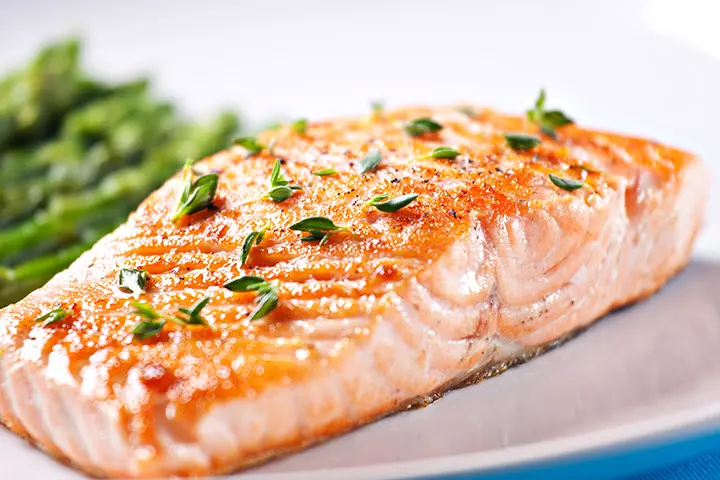
You will need
- Salmon fillet
How to make
- Preheat the oven to 356°F (180°C).
- Put the salmon into an ovenproof dish and bake it covered for about 20 minutes.
- After 20 minutes, check if the fish is cooked through and set it aside cool.
- Before serving, check if the fish has any bones and remove them.
- Flake a quarter of the salmon into a bowl using a clean fork and feed your baby.
 Quick tip
Quick tip2. Pumpkin and salmon puree (6+ months)
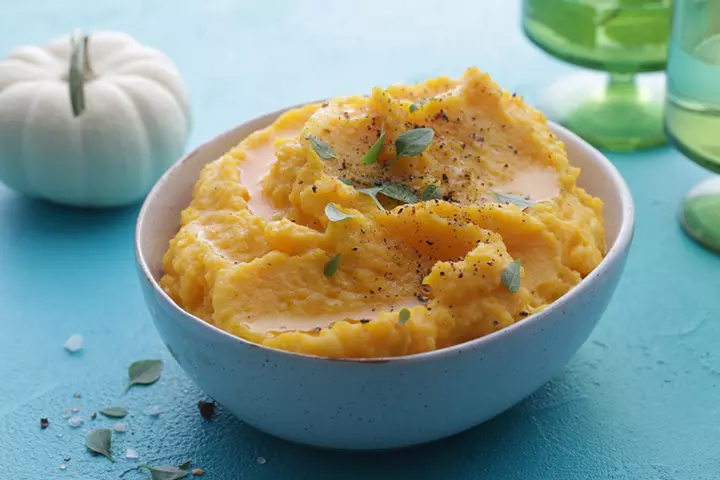
You will need
- ½ cup pumpkin (cooked and mashed)
- ¼ cup skinless and boneless salmon fillet (baked)
- ½ red onion (chopped)
- ¼ tsp lemon pepper seasoning
- 1tsp olive oil
How to make
- Put all the ingredients into a blender and blend well to make a smooth puree. Ensure no lumps are present.
- Add some water if the puree looks too thick. Then, pour the puree into a bowl and feed your baby.
- You can add one-fourth of a teaspoon of lemon juice to enhance the dish’s flavor.
3. Salmon sweet potato fish cake (8+ months)
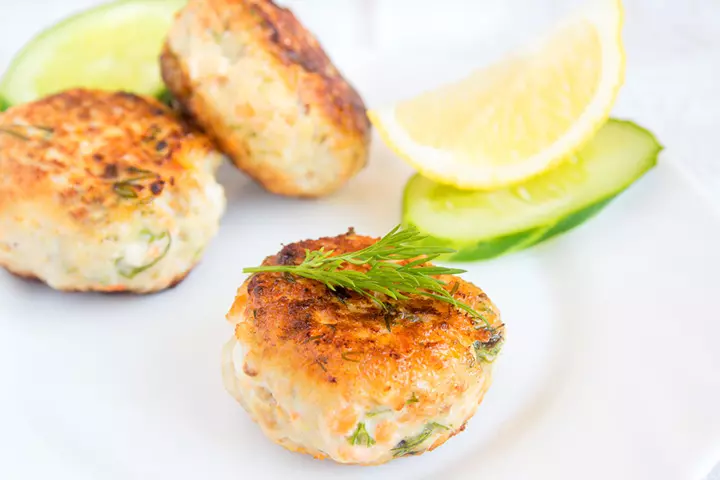
You will need
- 2 salmon fillets (cooked and finely chopped)
- 1 small sweet potato (mashed)
- 1 egg
- 1tsp dried dill
- 2tbsp green onion or chives (finely chopped)
- ¼ tsp black pepper powder
- 2tbsp olive oil
How to make
- Put all the ingredients (except olive oil) into a bowl and mix well until everything looks well combined.
- Scoop two to three tablespoons of the mixture, place it on your palm, and roll it slowly into a small cake/patty. Repeat the process and make cakes with the remaining mixture. Finally, place all the cakes/patties on a plate.
- Now, place an iron skillet over medium-high heat and add a tablespoon of oil.
- As the oil warms, place three to four patties on the skillet, leaving some space between each patty.
- Cook the patties for three to four minutes on each side. Once done, place them on a plate. Repeat the process with the other cakes.
- Serve one salmon sweet potato cake to your baby for self-feeding with yogurt-mint dip or avocado dip for added taste and nutrition.
- Ensure the baby eats the cake in small bites to avert any choking risks.
4. Salmon veggie frittata (12+ months)
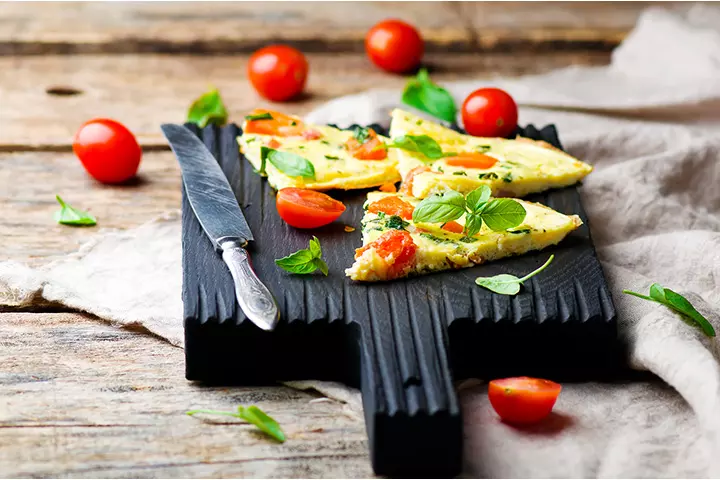
You will need
- 1 medium potato (peeled and diced)
- ½ medium sweet potato (peeled and diced)
- 1 canned salmon (drained and washed)
- 4 eggs (lightly whisked)
- ½ cup baby spinach leaves (washed and chopped)
- ½ cup mixed cheese (grated)
- 1tbsp olive oil
- 1-2tbsp water
How to make
- Preheat the oven to 392°F (200°C).
- Place the potato and sweet potato in a roasting tray, drizzle over some oil and give a gentle toss to coat all the diced veggies.
- Put the roasting tray into the oven and roast for about 20 to 30 minutes until the potato and sweet potato turn golden and tender.
- Meanwhile, preheat the grill. While the grill is heating, place a frying pan over low heat. Put the potato and sweet potato in the frying pan in a single layer.
- Next, add a layer of spinach leaves on the top of the potato and sweet potato layer. Then, on top, place the salmon and grated cheese.
- Pour the whisked eggs over the layers and let the dish cook over low heat for eight to ten minutes until the egg begins to set around the edges yet is still runny in the center.
- Once done, place the pan under the grill and cook for an additional five minutes until the egg sets and the frittata develops a golden brown top.
- After five minutes, remove the pan from under the grill and set it aside to cool. Cut into thick fingers and serve to your baby with a dip of your choice to help them develop healthy eating habits.
Barbara, a mother to two lively boys, discloses her simpler recipe that is centered around salmon and is loaded with the goodness of veggies, “A nutritious family meal, made by steaming skinless salmon, peas, baby spinach, and ripe avocado — a one-pot wonder that’s easy, fast, and freezable. After 8 minutes of steaming, blend everything into a smooth puree in a tall container, adjusting thickness based on the baby’s age. This versatile, healthy batch can be conveniently frozen for later use (ii).”
 Quick tip
Quick tip5. Salmon rice balls (12+ months)
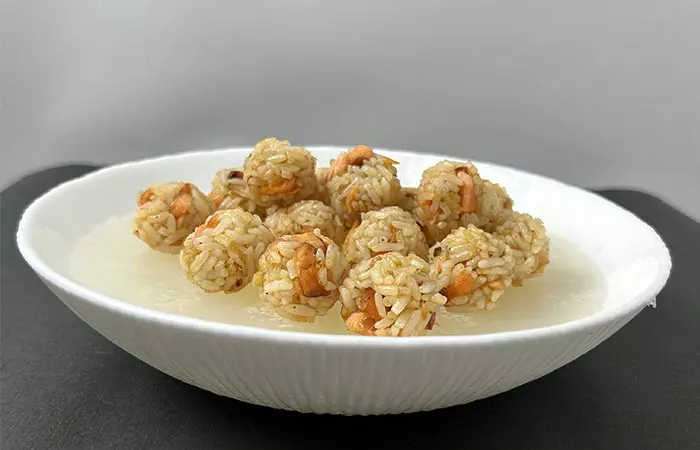
You will need
- ½ cup cooked salmon filet
- ¾ cup rice (sticky variety, cooked, cooled)
- ½ cup cheese (grated)
- 1 carrot (grated)
- 1 onion (medium, finely chopped)
- 1 bell pepper (finely chopped)
- ¼ cup olive oil
How to make
- Preheat the oven to 200°C.
- Shred the salmon filet with a fork.
- Add olive oil, grated carrot, chopped onion, and bell pepper to a pan on medium heat.
- Take out the mixture in a large bowl, add salmon, rice, and cheese to it, and mix well.
- Scoop out tbsp-sized portions of the mixture and use your hands to press and roll them into balls (wetting your hands a bit gives better results). You can also use a rice baller for convenience.
- Coat the baking tray lightly with olive oil and bake the balls for 25 to 30 minutes at 200°C or until golden.
Frequently Asked Questions
1. Can I freeze cooked salmon for my baby?
Yes, cooked salmon can be frozen at 0°F/-17.8°C or less in sealed freezer-safe bags or airtight plastic containers for approximately three months; however, the texture and flavor of the fish will suffer from a lengthy storage time in the freezer (20).
2. How should I steam salmon for baby food?
To serve steamed salmon to babies, first, remove all the bones. Then, steam a small portion of salmon on a dish over high heat until cooked. Use a fork to mash the salmon meat and feed it to your baby by mixing it in various baby food recipes. You can also give your baby steamed mashed or pureed salmon directly by adding water or breastmilk and mixing it to the desired consistency.
3. Is it safe to give my baby raw salmon?
No, it is not safe to give raw fish to babies. Raw fish can contain bacteria and parasites that can cause infections and food poisoning. Fish must be cooked to an internal temperature of at least 145 °F (or 62.77°C) to ensure that it is safe for consumption by babies (21).
4. How often can I feed salmon to my baby?
Babies may eat about two servings a week of salmon, where one serving amounts to about one ounce (22).
Salmon for babies is safe and beneficial when introduced in an age-appropriate manner. You may serve salmon for toddlers and babies in moderation as a part of your healthy, well-balanced diet, owing to its several health benefits. Initially, you may offer salmon in a puree or mashed form and gradually add various salmon recipes such as cakes and finger foods to your child’s diet. However, while buying salmon, pick a high-quality fish cultivated in proper storage to preserve its quality and facilitate safe consumption.
Infographic: More Ways To Include Salmon In Your Baby’s Diet
Salmon can be a healthy inclusion in your baby’s diet, but your baby may not like it when served alone. Combining it with other vegetables can enhance its taste and make it more acceptable for the baby. The infographic below lists combinations that go well with salmon and make it more appealing for your baby. Illustration: Momjunction Design Team
Illustration: Salmon For Babies: Safety Right Age Benefits And Recipes

Image: Stable Diffusion/MomJunction Design Team
Delicious and nutritious! Learn how to make a simple salmon and sweet potato dish for your baby through this video.
Personal Experience: Source
MomJunction articles include first-hand experiences to provide you with better insights through real-life narratives. Here are the sources of personal accounts referenced in this article.
i. Half a Pound of Tuppenny Rice. A Beginner’s Guide To Weaning.https://blowyourowncrumpet.wordpress.com/tag/nigella-lawson/
ii. Salmon avocado greens baby food recipe.
https://www.youtube.com/watch?feature=shared&v=LktF7zf6mYY
References
1.Salmon, Seafood Health Facts: Making Smart Choices; Delaware Sea Grant
2. American Academy of Pediatrics Says US Children Are Not Eating Enough Seafood; AAP
3. Essential Fatty Acids; Oregon State University
4. Salmon Baby Food Gives a Nutritional Boost to Infants and Toddlers; USDA
5. AAP Clinical Report Highlights Early Introduction of Peanut-based Foods to Prevent Allergies; AAP
6. Starting Solid Foods; AAP
7. Magnusson, Jessica, et al. Fish Consumption in Infancy and Development of Allergic Disease up to Age 12 Y AAP ;The American Journal of Clinical Nutrition
8. When, What, and How to Introduce Solid Foods; Centers for Diseases Control and Prevention
9. Reduce Exposure to Contaminants in Fish;Washington State Department Of Health
10. Choking Injuries and Deaths are Preventable!The New York State Department of Health
11. Fish salmon pink raw FDC ID: 175138; Food Data Central
12. Dietary Guidelines for Americans 2020-2025; USDA
13. Farmed Salmon vs. Wild Salmon; Washington State Department Of Health
14. Health Benefits Of Salmon For The Heart Brain And Much More; Safe Beat
15. Do Kids Need Omega 3 Fats; Eat Right; Academy of Nutrition and Dietetics
16. Health Benefits of Salmon: Pt. 1; IFIS
17.Keisuke Kokubun et al.; Fish Intake May Affect Brain Structure and Improve Cognitive Ability in Healthy People; National Center for Biotechnology Information
18. What Is Fish Allergy?; Food Allergy Research & Education
19. Fish Allergy; ACAAI
20. How long can you store fish?; AskUSDA
21. Advice about Eating Fish; FDA
22. Is Raw Fish Safe? What To Know Before You Eat; Cleveland Clinic 23. Choline; National Institute of Health
Community Experiences
Join the conversation and become a part of our nurturing community! Share your stories, experiences, and insights to connect with fellow parents.
Read full bio of Dr. Elizabeth Roberts
Read full bio of Swati Patwal
Read full bio of Rohit Garoo
Read full bio of Ghazia Shah






 Quick fact
Quick fact





